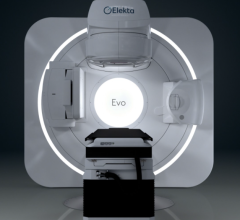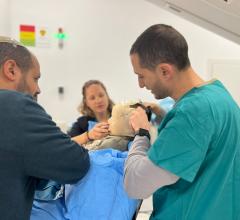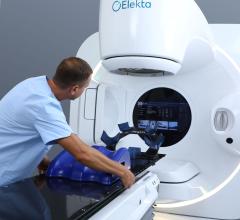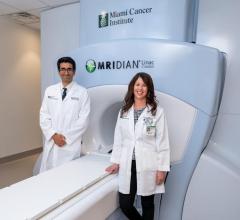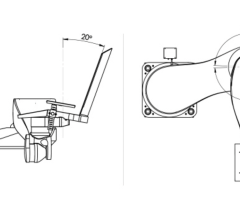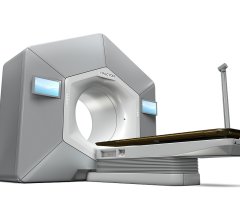The challenge in radiation therapy is to deliver the optimal amount of dose with enough precision to avoid damaging healthy surrounding tissue. Add to that, the reimbursement pressures of a fiscally tight healthcare environment that forces clinicians to put a premium on patient throughput, and the window of accuracy narrows. Balancing speed and accuracy in treating patients with radiation therapy requires professionals with critical thinking and strategic planning skills who can fuse art with science. You will find these clinicians in our annual review of the “Top IMRT/IGRT Centers to Watch” for 2008.
This review recognizes the most forward-thinking U.S. cancer treatment centers that are using advanced techniques and technology, such as intensity-modulated radiation therapy (IMRT) and image-guided radiation therapy (IGRT), to help their patients and to make a difference.
Some of the high profile radiation oncology centers in the U.S. are well known leaders, such as M.D. Anderson (Houston, TX), the Memorial Sloan-Kettering Cancer Center (New York, NY), Johns Hopkins Hospital (Baltimore, MD) and the Mayo Clinic (Rochester, MN).
In addition to these centers, we asked our readers to select this year’s “Top IMRT/IGRT Centers to Watch.” Readers nominated worthy facilities based on their achievements in innovation, operational efficiency, patient service and teamwork. From there, the editors have chosen the top facilities to watch in 2008, classifying them as influential market leaders.
1. University of Maryland (Baltimore, MD)
The University of Maryland in Baltimore, leads off our “Top IMRT/IGRT Centers to Watch” list because this facility is exemplary in achieving the unique balance between technical innovation, efficiency, patient care and teamwork.
Innovation: The University of Maryland was the first in the region to offer IMRT to its patients both in the main facility in Baltimore and at its community sites. Throughout the years, the faculty members in the department of radiation oncology have developed several unique IMRT methods and applied them clinically to optimize patient care. One of the techniques is intensity modulated arc therapy (IMAT), a method invented by one of the physicists. Rather than using fixed intensity modulated beams, IMAT uses overlapping rotational beams. Because all beam angles are considered during plan optimization, IMAT has the potential to improve plan quality. Because IMAT is delivered with continuous rotation, the total treatment time is less, allowing more patients to receive the benefits of IMRT.
Another innovation is Direct Aperture Optimization (DAO). Rather than using the conventional two-step process in planning IMRT, DAO directly optimizes the treatment beam apertures and their weightings. Highly conformal IMRT plans can be generated with limited number of apertures. For many cases, the use of DAO allowed the reduction of treatment time from 30 minutes to less than 10 minutes.
In the area of IGRT, University of Maryland is the first in the Mid-Atlantic region to adopt image-guided radiation therapy using cone- beam CT from Varian Trilogy in 2005. For managing target motion, the radiation oncology department implemented gated radiation delivery using the Varian RPM system. The faculty members at the University of Maryland have successfully obtained NIH funding to develop a real-time tumor tracking technology. They are regarded as pioneers in the areas of four-dimensional CT and tumor tracking.
Operational Efficiency: The department of radiation oncology meets regularly to carefully examine all treatment procedures for potential quality improvement and operational efficiency. The department also migrated to VARiS for better integration of the workflow with new Varian equipment.
Patient Care: The University of Maryland has a patient-friendly waiting area highlighted by a two-story atrium with ample natural light. Each patient has an employee assist with his or her paperwork to answer any questions and to help the patient understand and to complete the process as efficiently as possible. The front desk staff is trained to always be cognizant of patient waiting time and comfort. Patients waiting are frequently checked to see if there is anything they need to make their wait more comfortable.
To act as an aid in educating patients about radiation therapy, the department developed an award-winning video and handbook that received both local and national attention. The department also instituted a patient navigator to guide patients through a potentially complex system. The key component that assisted the patient navigator and all staff in efficiently managing the patient was the introduction of VARiS, which has led to increased patient satisfaction and throughput.
Teamwork: Patient care is the primary focus of all employees who consistently look for ways to improve the overall experience for the patient, both in terms of visit satisfaction and treatment outcomes and satisfaction. Recurring meetings that focus on patient care are attended by physician leadership, administration leadership and representatives from the clinic (front desk, therapy and nursing) to solicit input on ways to make the clinic run more efficiently.
2. Rocky Mountain CyberKnife (Boulder, CO)
Innovation: At Rocky Mountain CyberKnife doctors treat benign tumors, malignant tumors, vascular malformations and functional disorders located in the brain, spine, skull base, orbit, musculoskeletal, lung, liver, pancreas and prostate. This center employs the Accuray Cyberknife system because it offers rapid relief from pain and other symptoms, and recovery is often immediate, given its low risk of complications and damage to healthy tissue. Treatments tend to last between 30 and 60 minutes.
The site started using the touchscreen monitor that is now included with all Cyberknife systems. They visualize the target motion before treating Synchrony patients. The Synchrony System is designed to allow physicians to treat patients with much tighter margins, eliminating the need to extend margins to compensate for a moving target, and thus spare healthy surrounding tissue. The Synchrony System tracks both movement of the tumor and breathing patterns of the patient. The robotic arm adjusts and compensates for these movements ensuring more accurate treatment and eliminating breath-holding or gating requirements, allowing patients to breathe normally throughout their treatment.
Physicians also use the Xsight Spine and Xsight Lung Tracking Systems, which integrate with the CyberKnife Stereotactic Radiosurgery System (SBRT). Xsight eliminates the need for surgical implantation of fiducials by using actual bony structure of the spine and highly sophisticated image processing techniques to orient and locate the lesion during the delivery of radiosurgery treatments for spinal and lung tumors. Xsight Spine is used for treating lesions throughout the spinal region — including cervical, thoracic, lumbar and sacral tumors.
Operational Efficiency: To improve operational efficiency, Medical Physicist Steve Humphries, Ph.D., has integrated the open source DICOM image viewer/manipulator/3D and 4D rendering tool/storage-archives-PACS application “OSIRIX” throughout the center’s internal and external operations.
Patient Care: The staff are very patient oriented, and patients say the room is beautiful and they feel very comfortable with the staff.
Teamwork: The team may include a surgeon, radiation oncologist, medical oncologist, medical physicist, nurse, radiation therapist and other team members within the clinic. The team is experienced and cross-trained, enabling the clinicians to understand each other’s perspective. The doctor can plan, the physicist and RTT can contour and know what the prescriptions should be, contributing to operational efficiency. As a result, the time it takes to move a patient between consult and treatment is very brief.
3. MIMA Cancer Center (Melbourne, FL)
Innovation: Starting in 2004, the MIMA Cancer Center (MCC) was the first radiation oncology department in the world to install image-guided radiation therapy (IGRT) technology on all of its machines and routinely use the technology on all curative patients. MCC transitioned to Varian OBI/CBCT technology in late 2005. In 2006, routine use of Varian’s respiratory gating technology was brought online for the treatment of lung and upper abdominal tumors. MCC has had three IGRT abstracts accepted at ASTRO in the last two years and three major publications in the peer-reviewed literature.
In 2007, routine use of Varian’s respiratory gating technology was brought online for the treatment of lung and upper abdominal tumors.
Operational Efficiency: MCC opened in 2003 and is part of Melbourne Internal Medicine Associates (MIMA), a 100-plus multispecialty physician group in Brevard County, FL, and a $150-million-dollar-a-year corporation. MIMA is paperless with an advanced EMR and PACS. MCC’s chief physicist, Joseph Ting, Ph.D., establishes synergistic and strategic partnerships with major vendors, particularly Varian, to keep MCC at the forefront of technology. The center’s medical director, Todd Scarbrough, M.D., has modeled much of the flow and philosophy of the MCC after his former institution, which earned Outpatient Care Technology’s inaugural 2006 Outpatient Excellence Award for Oncology Centers. “Growth” and “efficiency” have been the watchwords of MCC since its inception as a single-linear accelerator/one radiation oncologist/eight staff member/100 annual patients enterprise in 2003. Today, the center houses approximately 45 staff members, three linear accelerators (with a fourth in construction), dedicated CT and PET/CT technology, and treats upwards of 1,000 patients per year.
Patient Care: MIMA prides itself on outstanding customer service and its continued improvement. Press Ganey Associates Inc. patient satisfaction measurement services are employed MIMA-wide for purposes of assessing and improving patient satisfaction. Patient satisfaction questionnaires at MCC, completed at the end of patients’ treatments, are continuously monitored and analyzed. MCC and MIMA score well above the national average in terms of patient satisfaction in most metrics. MIMA, due to its cohesiveness and size, affords a continuity of care and breadth of service (surgery, radiology, infusion center/chemotherapy, etc.) unmatched in central Florida.
Teamwork: Administration support is key to MCC’s success with a strong commitment to being at the forefront of technology, operating efficiently and profitably and providing world-class cancer care since MCC’s opening. This commitment stems from the CEO, Joseph McClure, M.D., Ph.D., M.B.A., through MIMA’s leadership, the staff and physicians at MCC, and on through to the director of radiation oncology, Fred Fangman, R.T.T. Teamwork has held MCC together and given the center a stellar local reputation, despite the challenges of growing pains and continued reimbursement challenges.
4. Central Arkansas Radiation Therapy Institute (Little Rock, AR)
Innovation: Central Arkansas Radiation Therapy Institute (CARTI), a nonprofit radiation therapy center with seven facilities located throughout Arkansas, installed the BrainLAB ExacTrac X-Ray 6D image-guided radiation therapy (IGRT) system, enabling doctors to pinpoint tumors with increased accuracy and treat a wider variety of indications.
Operational Efficiency: Implementing the new system offered a high level treatment accuracy, resulting in fewer complications and better treatment outcomes, as well as improved workflow to maximize patient output.
Customer Service: In addition to the physical aspects of cancer, patients are also faced with problems ranging from transportation needs to family concerns. The office staff at CARTI assists with housing, transportation, financial concerns, cancer education materials and a plethora of other services for the patients’ and families’ mental and emotional well-being.
Teamwork: With the arrival of the ExacTrac X-Ray 6D system, patients with tumors that were previously considered not suitable for precision radiotherapy now have new hope due to the technology’s ability to precisely deliver a highly focused radiation dose right to the tumor. Greater accuracy means that oncologists can now treat a wider range of indications, including prostate, lung, liver and spine.
5. Baptist Centers for Cancer Care’s Radiation Oncology Center (BCCC ROC) (Memphis, TN)
Innovation: BCCC ROC bills itself as the first in the area to offer freestanding prostate brachytherapy with intraoperative dosimetry, three-dimensional high-dose rate brachytherapy, intensity-modulated radiation therapy (IMRT), image-guided radiation therapy (IGRT), respiratory gating and linear accelerator-based stereotactic radiosurgery (SRS) and stereotactic radiotherapy (SRT). In fact, within the last two years, BCCC ROC invested more than $5 million in equipment, which included the addition of a new HDR treatment area, upgrading its existing accelerator consoles to 4DTC and electronic medical record software as well as computer hardware. The facility also has initiated a “strong” gynecologic service and new SRS/SRT program. The multimillion-dollar investment in capital equipment and technology included a brachytherapy suite, IGRT and Trilogy system, plus an EMR and ARIA oncology information management system. Baptist uses GE Healthcare for computed tomography (CT) and positron emission tomography (PET/CT) imaging; C.R. Bard for radioactive material for the ProSeed prostate brachytherapy implant technique; B-K Medical for ultrasound; PAR Scientific A/S for block cutters; Scanditronix Wellhofer for physics calibration equipment; and CIVCO Medical Solutions for immobilization devices and treatment supplies.
Operational Efficiency: The planning systems move between treatment units, and the facility works with other hospitals within the organization to move critical patient information between systems.
The team manages productivity, for example, by rotating through dosimetry for the therapists. This increases employee satisfaction/morale and provides professional development in a hard to recruit position to meet existing and future needs.
Patient Care: A dedicated ambulance team transports hospital inpatients to the center, which is located next to a hotel that can serve as a convenient stop for out-of-town patients and their families and friends.
Teamwork: The facility works with sister hospitals to provide services to patients by sharing a medical physicist, dosimetrist and therapists. Medical oncologists are in private practice; radiologists are contracted by the hospital.
Feature | September 03, 2008 | Cristen C. Bolan and Rick Dana Barlow
Top IMRT/IGRT cancer treatment centers achieve a unique balance between innovation and patient care.


 June 14, 2024
June 14, 2024 

